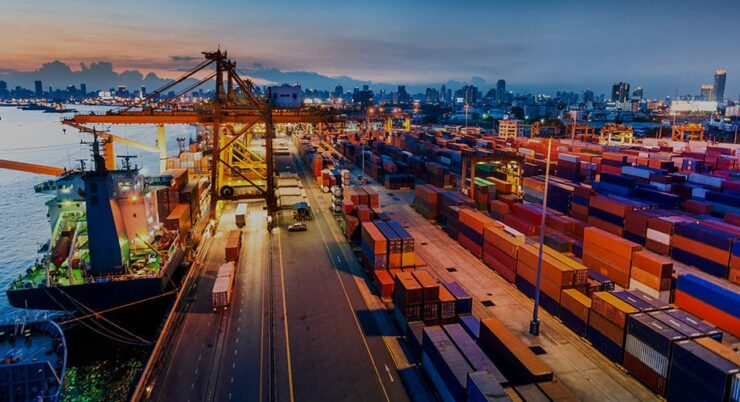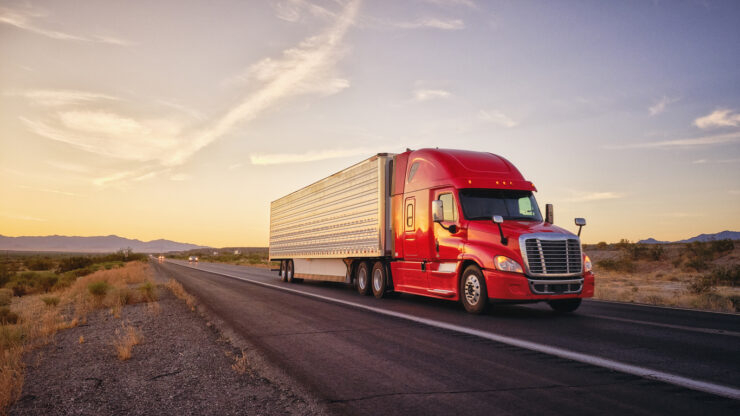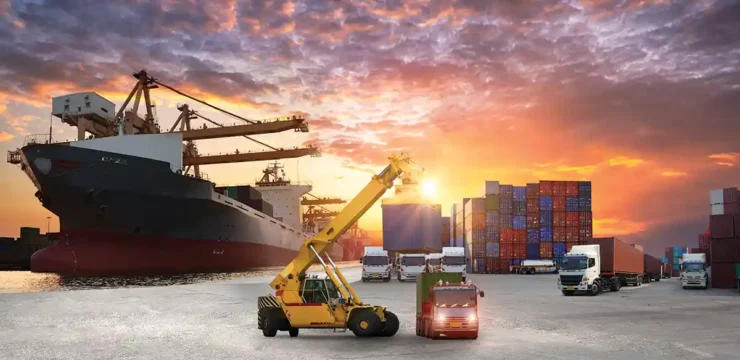In the intricate tapestry of modern commerce, logistics is the lynchpin that synchronizes the movements of goods, information, and resources across vast and complex supply chains. From the inception of production to the final delivery, the science of logistics orchestrates a symphony of activities that drive economies and industries forward.
This comprehensive pillar article is designed to lead you through the multifaceted realm of logistics, from its fundamental essence to the intricacies of its various types and strategies. Additionally, we’ll delve into the diverse world of trucking, a cornerstone of logistics, exploring its various types and applications.
Unraveling the Core Concepts of Logistics

Logistics, at its essence, represents the meticulous planning, execution, and management of the efficient flow, storage, and distribution of goods, services, and information. It encompasses an array of interconnected processes that collaborate to meet customer demands, optimize costs, and drive operational excellence.
Procurement and Sourcing: A Nexus of Supply
Procurement and sourcing constitute the cornerstone of logistics, encompassing the acquisition of raw materials, components, and finished products from suppliers. This process is the genesis of the supply chain, where strategic decisions lay the foundation for seamless operations.
Transportation Dynamics: The Art of Efficient Movement
Transportation is the circulatory system of logistics, propelling goods across vast distances via road, rail, air, or sea. The intricacies of transportation logistics delve into optimizing routes, modes, and carriers to minimize transit times and costs.
Transport Management
Transport management consulting is a specialized service that offers expert advice to businesses and organizations involved in transportation. Transport management consulting encompasses the planning, execution, and optimization of the movement of goods, people, or services from one location to another. It is a critical component of logistics and supply chain management and is crucial in various industries, including manufacturing, retail, distribution, and service.
Critical aspects of transport management include:
- Route Planning: Identifying the most efficient routes for transporting goods or people to minimize costs, reduce travel time, and optimize resource utilization. This involves considering distance, traffic conditions, road restrictions, and delivery time windows.
- Carrier Selection: Choosing the appropriate transportation providers, whether they are in-house or external carriers (such as trucking companies, airlines, or shipping companies), based on factors like cost, reliability, capacity, and service quality.
- Load Planning: Efficiently organizing and loading goods onto vehicles or containers to maximize space utilization while ensuring safe and secure transportation.
- Scheduling and Dispatching: Coordinating the timing and sequencing of transportation activities to meet delivery deadlines and customer expectations. This includes assigning drivers, vehicles, and routes.
- Tracking and Monitoring: Utilizing technology (e.g., GPS, RFID, telematics) to track the real-time location and condition of goods in transit. This helps in ensuring visibility and transparency throughout the transportation process.
- Compliance and Documentation: Managing regulatory compliance, permits, licenses, and documentation required for transporting goods across borders or through different jurisdictions. This can include customs clearance, safety regulations, and environmental standards.
- Cost Management: Controlling transportation costs by optimizing routes, consolidating shipments, negotiating favorable rates with carriers, and minimizing unnecessary delays and expenses.
- Risk Management: Determining and mitigating risks associated with transportation, such as accidents, theft, damage to goods, or disruptions in the supply chain.
- Environmental Sustainability: Implementing strategies to reduce the environmental impact of transportation, such as using fuel-efficient vehicles, promoting alternative fuels, and minimizing emissions.
- Performance Analysis and Optimization: Continuously evaluate transportation operations’ efficiency and effectiveness through data analysis, performance metrics, and feedback from customers and stakeholders. We are making necessary adjustments to improve overall performance.
Transport management consulting services and software solutions, such as transport management systems (TMS), are often used to streamline and automate many of these processes, making them more efficient and responsive. Effective transport management consulting is essential for businesses aiming to meet customer demands, reduce costs, improve supply chain reliability, and minimize environmental impact.”
Warehousing and Inventory Mastery: Balancing Supply and Demand
Warehousing and inventory management present the delicate balancing act between supply and demand. Warehouses are the strategic nerve centers of logistics, housing goods, and products at various stages of the supply chain. Effective inventory management ensures products are available when needed, without overburdening storage capacity.
Distribution and Fulfillment Strategies: Meeting Customer Desires
Distribution and fulfillment strategies bridge the gap between warehouses and end consumers. The challenge is to synchronize deliveries to reduce lead times while minimizing costs and meeting customers’ ever-evolving expectations.
Information Flow: The Backbone of Modern Logistics
In the digital age, information flow stands as the backbone of modern logistics. Real-time data sharing via advanced technologies, such as the Internet of Things (IoT) and predictive analytics, enables stakeholders to track shipments, monitor inventory levels, and make data-driven decisions.
Exploring the Spectrum of Logistics Types

Supply Chain Management (SCM)
Supply Chain Management (SCM) serves as the orchestral conductor of logistics activities. It’s the holistic management of all facets of the supply chain, involving collaboration between partners to optimize processes and meet customer demands.
Inbound and Outbound Logistics
Inbound logistics focuses on the movement of raw materials and components to manufacturers. Outbound logistics pertains to the distribution of finished products from manufacturers to consumers.
Reverse Logistics
This form of logistics navigates the journey of products from their final destination back to the manufacturer or designated locations. It includes activities like product returns, repairs, recycling, and responsible disposal.
Third-Party Logistics (3PL) and Fourth-Party Logistics (4PL)
3PL providers offer specialized logistics services such as transportation and warehousing. 4PL takes a more comprehensive approach, managing the entire supply chain, often involving multiple 3PL providers.
E-commerce Logistics
The surge of online shopping has spurred tailored logistics strategies. E-commerce logistics encompasses last-mile delivery, omnichannel fulfillment, and strategies to manage returns and exchanges.
Global Logistics
Operating across borders introduces a complex web of regulations, customs, and cultural considerations. Global logistics encompasses the challenges of international trade, necessitating expertise in navigating diverse markets.
1PL vs 2PL vs 3PL vs 4PL vs 5PL: Unraveling the Complexity
The evolution of logistics has given rise to different models of service providers, each offering distinct advantages. 1PL (First-Party Logistics) refers to a company’s in-house logistics, which manages all aspects of transportation, storage, and distribution. 2PL (Second-Party Logistics) entails companies outsourcing their transportation and storage needs to specialized providers. 3PL (Third-Party Logistics) providers offer a range of services, including transportation, warehousing, and even order fulfillment. 4PL (Fourth-Party Logistics) providers take a more strategic role, managing entire supply chains, often using multiple 3PLs. 5PL (Fifth-Party Logistics), while not as commonly defined, is a term emerging to describe consulting firms that specialize in logistics strategy.
The World of Trucking in Logistics

Trucking is a pivotal component of logistics, especially in countries like the United States, where vast distances are covered daily to deliver goods. Different types of trucks cater to various transportation needs, and they come in a multitude of configurations tailored to the cargo they transport.
Open Deck Trucks
Open deck trucks, often referred to as flatbed trucks, boast an open platform without a roof or sides. This design flexibility makes them optimal for transporting large, heavy, or oddly shaped items, such as construction materials, machinery, and oversized equipment. The unhindered loading and unloading process enhances their versatility.
Step Deck Trucks
Step deck trucks, alternatively known as drop deck or lowboy trucks, possess a lower deck height than conventional flatbeds. This configuration accommodates taller cargo that cannot fit under bridges or overpasses on standard flatbeds. Industries requiring the transportation of construction equipment and agricultural machinery favor step deck trucks.
Refrigerated Trucks (Reefer Trucks)
Refrigerated trucks, often colloquially called reefer trucks, are equipped with refrigeration units to safeguard perishable goods demanding temperature control. Their critical role extends to the transportation of fresh produce, dairy products, pharmaceuticals, and more. Maintaining the desired temperature throughout transit ensures product quality and safety.
Conestoga Trucks
Conestoga trucks offer a harmonious blend of the flexibility of flatbeds and the protection of enclosed trailers. The ingenious Conestoga system features a flatbed truck paired with a rolling tarp system. This arrangement can be extended to cover and shield the cargo, providing weather protection while facilitating convenient loading and unloading procedures.
Curtain-Side Trucks
Curtain-side trucks, also identified as tautliners, sport curtain-like sidewalls crafted from durable fabric. This design grants swift and accessible cargo entry from the sides, making them a preferred choice for transporting goods requiring rapid loading and unloading.
Technology’s Transformation of the Trucking Landscape

As technology continues to evolve, the trucking industry is undergoing a profound transformation. Innovations are driving efficiency, safety, and sustainability, all of which resonate throughout the logistics ecosystem.
Telematics and Fleet Management
Telematics systems integrated into trucks provide real-time data on vehicle performance, location, and driver behavior. Fleet managers leverage this information to optimize routes, enhance fuel efficiency, and ensure compliance with safety regulations. The ability to remotely monitor trucks enhances operational transparency and responsiveness.
Eco-Friendly Advancements
The push for sustainability has led to the development of eco-friendly trucks, including electric and hybrid models. These vehicles offer reduced emissions and lower operating costs, aligning with the industry’s efforts to minimize its environmental footprint. The integration of alternative fuels and advanced propulsion systems further contributes to greener trucking operations.
Automation and Autonomous Trucks
Automation is reshaping trucking with the advent of semi-autonomous and autonomous trucks. Advanced driver assistance systems (ADAS) enhance safety by assisting drivers with tasks like lane keeping and adaptive cruise control. Fully autonomous trucks, once deployed, could address driver shortages, optimize fuel efficiency, and enhance road safety.
Logistics & Trucking
The dynamic world of logistics, intricately woven with the tapestry of trucking, is in a perpetual state of evolution. From the strategic orchestration of supply chains to the precision of selecting the right truck for the job, every facet of this field plays a pivotal role in shaping the global movement of goods.
As industries continue to expand, economies grow, and technology advances, logistics, and trucking remain the backbone of commerce. Their symbiotic relationship propels products from their origins to the hands of consumers, bridging gaps in geography, time, and demand.
The journey of logistics is far from over, and as we navigate an ever-changing landscape, one thing remains clear: the world relies on the art and science of logistics to keep things moving, from raw materials to finished products and everything in between.

